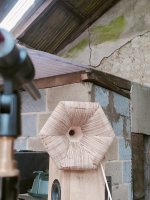And the Peerless DFM-2535R00-8 on the Athex 400

Slight caution here - this driver had audible distortion, so might be damaged/loose diaphragm?
Slight caution here - this driver had audible distortion, so might be damaged/loose diaphragm?
I've been cutting the test horns out of EPS foam on my cnc - it's very quick! It seems that a covering of microfibre cement makes a very nice hard yet sandable coating. Its probably possible to get a very nice finish with more sanding and more coats and then a varnish/epoxy finish. Definitely easier than my wooden gramophone style horns.
Thanks a lot for these! I'm aware that it is smoothed (quite a lot) but it seems to me that there's really no way back, as the LF extension is remarkable. Still waiting for a downside! 🙂
I'm curious about your listening impressions.
I'm curious about your listening impressions.
1/3 octave smoothing ..... that's hiding quite a lot. Could it be shown with 1/12 octave smoothing?
I'll post with less smoothing later. Tiny changes to the test setup can make all sorts of ripples and dips appear and I didn't want to get bogged down chasing them away.
I'll make a short video of the process in the next couple of days@maravedis Do you have any pictures of your workflow using the foam?
I had very strong opinions about each test setup - most of which were confirmed after a quick eq and added bass/mid mono listening test (with my favourite solo violin bach recording). I'll write about it properly but clearly the vintage alnico was by far the most involving and exciting on any horn (need to test it on the little beamer too). I think the Radian will probably amazing in the right setup too, let's see.
Finally finally, here's the vintage alnico on the ATHEX-E-280-25. (note 1/12th octave smoothing!)

It's a JBL2420 with original aluminium diaphragms. It would be great if they made Beryllium diaphragms but I don't think they exist. Looking forward to see how they take high eq. (I've found Radian Beryllium drivers are so easy to eq with no ill effects)
I get this as I had gone through all types of profiles and experienced the same. I have ended up with tractrix and JMLC profiles at home. I still have a number of different horns to test. However, every time I get to listen to a Western Electric 15a system I am floored. It is an exponential horn. It does have problems when pushed too much for bandwidth but it does things no other speaker I listened can do. It is also being used differently by a number of people. Active setups with time alignment and bandwidth limited to 1-1.5khz.Neither exponential nor straight conical horns are suitable for high quality sound reproduction. The former because of its strong beaming and the latter because of the abrupt termination, limiting the use to a narrow band.
What is it that they do? Is it because it can cover from 100hz to 1.5khz without much problems, or is it something else?
I think for midbass the exponential profile works very well because the loading in this range is very good. The mouth area can be a bit smaller in exchange for a somewhat longer path length. It worked well for me in the midbass. Maybe directivity is also good to have in the midbass, but I have not investigated this empirically.What is it that they do?
As promised, the DFM-2544 + ST260 (approx. 0 - 50/10 deg):I would say yes. If you wait a week or so I can measure this combination.
(The WG/driver interface could be improved, as I didn't remove the bug screen, etc.)
The same driver (the same piece) in the extended ATHEX 460-36:


If we assume the sensitivities to be about equal around 10 kHz (which could be, but I didn't check, unfortunately), this would mean ~15 dB gain at 500 Hz... (to a degree it's also due to the bigger WG)
If we assume the sensitivities to be about equal around 10 kHz (which could be, but I didn't check, unfortunately), this would mean ~15 dB gain at 500 Hz... (to a degree it's also due to the bigger WG)
Last edited:
- Home
- Loudspeakers
- Multi-Way
- Acoustic Horn Design – The Easy Way (Ath4)
